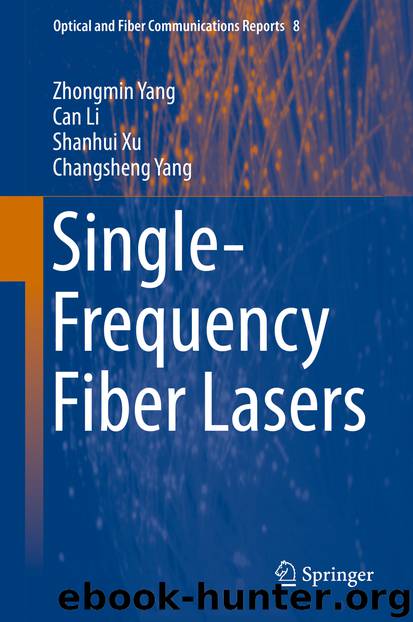Single-Frequency Fiber Lasers by Zhongmin Yang & Can Li & Shanhui Xu & Changsheng Yang

Author:Zhongmin Yang & Can Li & Shanhui Xu & Changsheng Yang
Language: eng
Format: epub
ISBN: 9789811360800
Publisher: Springer Singapore
4.2 Raman and Brillouin Fiber Lasers
In principle, the Raman and Brillouin scattering effects inside the optical fiber can both be utilized to achieve single-frequency lasers, given that the nonlinear gain bandwidth or the associated filter bandwidth is narrow enough to support only one longitudinal mode to survive. In this way, the main difference between the nonlinear fiber laser and the RE ions doped fiber laser is the origin of the optical gain, while the configuration of the laser cavity should be similar. By constructing a Raman fiber laser (RFL), one can achieve single-frequency lasing at wavelengths well beyond the gain bandwidth of RE ions, depending only on the availability of appropriate pump sources. However, since the gain provided by the SRS effect is quite small, the typical cavity length required for efficient operation of the RFLs is at least 100 m, and it is then difficult to realize single-longitudinal mode oscillation [3, 4]. On the contrary, the SBS gain is much larger than that of the SRS, while the bandwidth of the SBS gain is generally several tens of megahertz and is exceedingly smaller than that of the SRS gain (>10 terahertz). In addition, the dynamic process of the SBS has the advantages of a low-pass filter which can reduce the intensity and frequency noise of the pump laser, for instance, the linewidth of the generated Stokes signal is typically several orders of magnitude narrower than that of the pump source. In view of this, Brillouin fiber laser (BFL) has drawn much attention thanks to its merit of realizing low noise narrow linewidth single-frequency laser sources since its first demonstration [5].
To date, both linear and ring cavity configuration were examined for the BFLs. Generally, the linear BFL employs FBG or optical circulator to make up a F-P cavity which allows the Brillouin to pump light and the SBS light to oscillate inside the resonator. However, it suffers from the problems such as the low output power and the generation of high-order Stokes and anti-Stokes light compared with the ring cavity BFLs, which also shows a comparatively simplicity [6, 7]. Figure 4.1 shows a typical structure of the ring cavity BFL, in which only an optical fiber coupler is used to launch the pump laser and couple a part of the light out of the ring cavity. The lasing mechanism is that the pump light reflects by a co-propagating index grating that induced by the thermally excited acoustic wave in the fiber and the produced counterpropagating Stokes light is correspondingly frequency downshifted according to the Doppler effect.
Fig. 4.1Typical structure of the ring cavity BFL
Download
This site does not store any files on its server. We only index and link to content provided by other sites. Please contact the content providers to delete copyright contents if any and email us, we'll remove relevant links or contents immediately.
Grails in Action by Glen Smith Peter Ledbrook(9163)
Sass and Compass in Action by Wynn Netherland Nathan Weizenbaum Chris Eppstein Brandon Mathis(8808)
Azure Containers Explained by Wesley Haakman & Richard Hooper(7444)
Configuring Windows Server Hybrid Advanced Services Exam Ref AZ-801 by Chris Gill(7433)
Kotlin in Action by Dmitry Jemerov(7263)
Running Windows Containers on AWS by Marcio Morales(6984)
Microsoft 365 Identity and Services Exam Guide MS-100 by Aaron Guilmette(5402)
Microsoft Cybersecurity Architect Exam Ref SC-100 by Dwayne Natwick(5212)
Combating Crime on the Dark Web by Nearchos Nearchou(4982)
The Ruby Workshop by Akshat Paul Peter Philips Dániel Szabó and Cheyne Wallace(4670)
Management Strategies for the Cloud Revolution: How Cloud Computing Is Transforming Business and Why You Can't Afford to Be Left Behind by Charles Babcock(4527)
Python for Security and Networking - Third Edition by José Manuel Ortega(4233)
The Age of Surveillance Capitalism by Shoshana Zuboff(4209)
Learn Wireshark by Lisa Bock(4119)
The Ultimate Docker Container Book by Schenker Gabriel N.;(3888)
Learn Windows PowerShell in a Month of Lunches by Don Jones(3681)
DevSecOps in Practice with VMware Tanzu by Parth Pandit & Robert Hardt(3568)
Windows Ransomware Detection and Protection by Marius Sandbu(3541)
Blockchain Basics by Daniel Drescher(3507)
